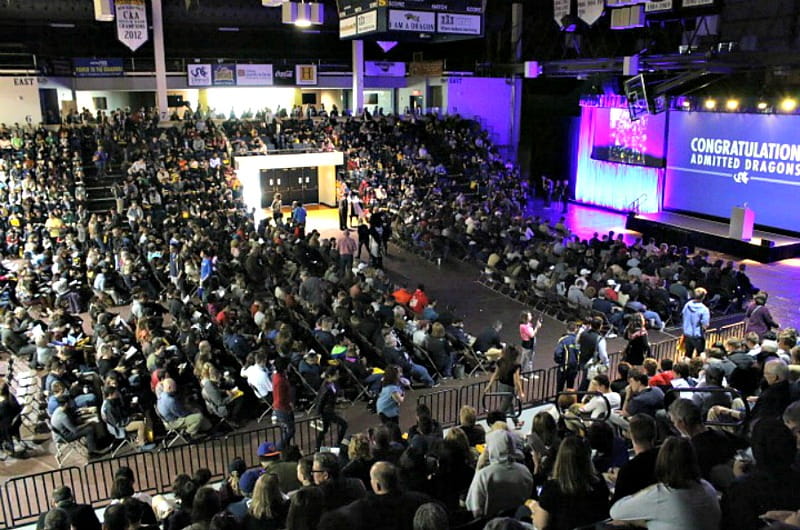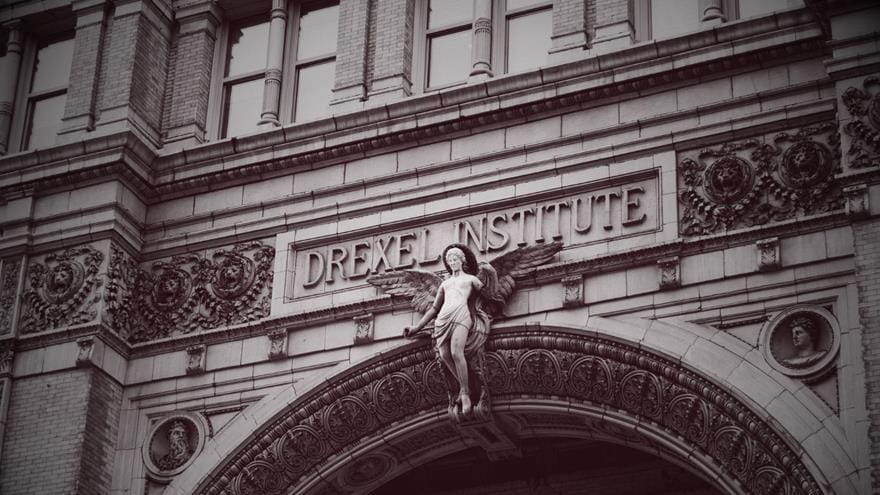Record-High Freshman Enrollment Projected for Fall 2017, Thanks to New Student-Success Strategy

Drexel University has received more than 3,500 deposits for the fall undergraduate class, representing a 43 percent increase over 2016 freshman deposits and a yield rate of 15.8 percent, the highest in recent years.
Drexel President John Fry said, “The success of our university-wide recruitment efforts for the next incoming freshman class shows that our student enrollment and retention strategy is solid and working.”
After an expected “summer melt” of students who submit a deposit but do not end up enrolling (a common practice that affects all colleges and universities), Drexel is projected to welcome an incoming class of roughly 3,100 freshmen this fall, well above the target of 2,400. These students will be part of a new generation of “right fit” Dragons who are more likely to remain and graduate, in line with an enrollment strategy implemented two years ago that anticipated, at least through the initial implementation, smaller but better qualified freshman classes, with more financial aid to increase student support and improve retention rates.
The increased understanding of the real value of a Drexel education, represented by the significant increase in yield rate, came sooner than anticipated. The University will work to ensure that all of the necessary support services — from housing to dining services to academic advising — are in place by September to welcome the incoming class.
“Moving forward, we can continue to build upon a student-success strategy that we know produces results,” said Senior Vice President of Enrollment Management and Student Success (EMSS) Randy Deike, PhD. “The entire Drexel community — the Division of Enrollment Management and Student Success, University Communications, the deans and many others — are helping to tell our story better.”
To do that, Drexel changed its outreach efforts, participating in 1,375 national and international high school visits, college fairs, off-campus receptions and counselor receptions, up from 75 in 2014. In addition to making continued greater investments in student financial aid, the University increased the number and — with the help of deans, faculty and professional staff members in its schools and colleges — improved the quality of “Admitted Student Days” on campus. New this year was the inauguration of “Presidential Scholars” breakfasts to better acquaint admitted, high-achieving students with Drexel, plus a national marketing campaign, “Ambition Can't Wait,” that launched this fall to raise awareness of the Drexel experience.
Drexel’s faculty, through the leadership of the deans of the schools and colleges, also increased the University’s exposure by creating special academic engagements with over 100 high schools in the local region, throughout the Northeast and internationally.
“In addition to curriculum enhancements and continually engaging students in the classroom, faculty have also found ways to sharpen the academic message for prospective students,” said Executive Vice President and Provost Brian Blake, PhD.
Beyond enrolling the right number of students, Drexel’s strategy calls for attracting students prepared to succeed on campus. To do that, the University is making new efforts to support students academically, financially, socially and in terms of their professional development.
To attract students best-suited to succeed at Drexel, Deike and his colleagues in EMSS made changes to past recruitment efforts. Communication to prospective students and their families, from website redesigns to marketing literature, was completely rewritten to better highlight both the academic and co-op experience that comes with a Drexel education. For example, to address confusion about whether students had to pay tuition while they were on co-op, a video was created to present easy-to-understand information about co-op and pricing.
“We really focused on closing the distance between the real value versus the perceived value of Drexel’s value proposition,” said Deike. “We have a great story to tell at Drexel, and we are telling it better than ever. And the word is getting out.”
Enrolling “right-fit” students and the enhanced support of student success is evidenced by the unparalleled increase in retention experienced with the fall 2015 freshman class. Approximately 89.1 percent of the fall 2015 freshmen returned to class for their sophomore year last fall — well above the national average retention rate of 75 percent. This one-year retention rate represents an increase of over four percentage points compared to the average of the previous five freshman cohorts. The fall 2016 class of freshmen looks to be tracking slightly ahead of the previous year’s tremendous showing and might be able to achieve the University’s goal of achieving a 90 percent one-year retention rate.
The test scores and GPAs of the incoming fall 2017 freshmen class were similar to those of last year’s, showing a continuation of the enrollment of qualified students.
Despite the recent success of Drexel’s “right-fit” enrollment strategy, University officials caution that cost-containment measures enacted this year will remain in place amid continued budget challenges for the next fiscal year and beyond.
“As we celebrate this important progress in a competitive higher education landscape that demands our very best efforts, we believe it is imperative to maintain the budget measures we enacted to reduce costs, as well as keep to our pledge to hold total increases in charges — such as tuition, room, board and fees — to 1.5 percent,” said Executive Vice President, Treasurer and Chief Operating Officer Helen Bowman.
The expected smaller enrollments realized during this transition — and subsequent drop in tuition-based revenue — created a five-year transition period in which the University must adjust to accommodate new revenue projections. The transitional period, ending in 2020, will help the University maintain a strong financial position at a time when many colleges and universities are experiencing lower enrollments and associated financial challenges. Already, Drexel has enacted a series of measures to enhance its financial strength.
In FY16, the University reduced its operating budget by $20 million through administrative restructuring, eliminating vacant positions as well as several dozen filled positions in almost every administrative area and at every level. For FY17, the University reduced its operating expenses or enhanced other revenues by $43 million to balance the budget, with colleges and schools reducing expenses by $9 million.
For FY18, the additional revenues generated by a larger incoming class will be offset by accompanying increases in financial aid and by the need to ramp up services to support these additional students, making expense reductions still necessary. The University plans to maintain the budget measures currently in place to control costs and will move forward with planned expense reductions for FY18.
As President Fry noted in a January town hall meeting, Drexel is committed to finding ways to increase revenue while reducing expenditures, improving efficiency and holding total increases in charges (tuition, room, board and fees) to 1.5 percent. Research, Drexel’s second-largest source of revenue after tuition, will be better supported and a $750 million fundraising campaign will be announced this fall.
In This Article
Drexel News is produced by
University Marketing and Communications.

